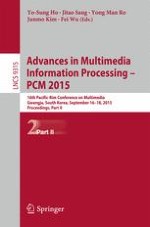The two-volume proceedings LNCS 9314 and 9315, constitute the proceedings of the 16th Pacific-Rim Conference on Multimedia, PCM 2015, held in Gwangju, South Korea, in September 2015.
The total of 138 full and 32 short papers presented in these proceedings was carefully reviewed and selected from 224 submissions. The papers were organized in topical sections named: image and audio processing; multimedia content analysis; multimedia applications and services; video coding and processing; multimedia representation learning; visual understanding and recognition on big data; coding and reconstruction of multimedia data with spatial-temporal information; 3D image/video processing and applications; video/image quality assessment and processing; social media computing; human action recognition in social robotics and video surveillance; recent advances in image/video processing; new media representation and transmission technologies for emerging UHD services.
